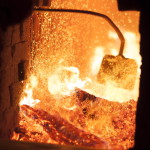The doors glow reddish-purple, smoke billows, and it hums like an engine.
It’s time again to fire up the brick kiln, and as the heat builds up to its 2,000-degree peak over the weekend, guests will be able to share one of the most unique sensory experiences Colonial Williamsburg has to offer.
From Wednesday, Nov. 18 through Sunday, Nov. 22, the Brickyard will be open for ticket and pass holders to view the final stage of making bricks the 18th-century way. Hours are 9 a.m. to 10 p.m. Wednesday through Saturday. Sunday the Brickyard will close as early as 5 p.m. depending on whether the firing is done.
It’s a unique atmosphere, especially near dusk. With light from the oven and the scattered cressets disappearing into the rising smoke, it’s a little eerie. The engine sound comes from the air being drawn through the spaces between the bricks. And then there’s the smell of, well, warming clay. That, too, is uncommon.
This year’s firing will be the biggest ever. Some 27,000 bricks have been stacked into formation. This type of kiln is called a “clamp,” a temporary structure that acts as a giant oven to cook the bricks. It’s about 30 feet long, 12 feet high, and 15 feet deep.
The clamp, unlike a more permanent kiln, is essentially made up of the bricks to be baked. They are stacked about a finger’s length apart, then topped off with a layer of previously fired bricks with no space between them. The whole structure is covered in a fresh layer of clay, stretched with some sand. It’s like the daub part of a wattle and daub house.
Nine channels run underneath the clamp, like separate little fireplaces at its base. At the beginning, the brickmakers will use kindling-size wood to warm up the oven, but they can’t let it get hot too quickly. The first hours of the firing are meant to steam the moisture out of the bricks. They’ll know it’s too hot if the bricks start to pop, meaning bricks are starting to burst. It happens every now and then.
Sometime Friday, once the steam coming out of the top has turned to smoke, the brickmakers will crank the temperature up by feeding a steady supply of wood into the tunnel openings. Twenty-plus cords of wood sit at the ready next to the kiln. More may be needed.
The brickmakers will be working round-the-clock, alternating 12-hour shifts, until the bricks are fully baked. And yes, they keep busy all night checking and feeding the fire. They even borrow a couple of people from other Historic Trades to help out.
Late Sunday the fire will be allowed to die down, and the kiln will slowly cool. Slowly, as in a week-and-a-half. There’s no rush to dismantle the clamp. The staff will get around to that in a couple of weeks. With no designated use this year, the bricks will be available as needed for projects large and small across the Historic Area.
An 18th-century brickmaker was typically not as skilled as most trades, but he knew what went into making a good brick. He would often work on site, overseeing a group of unskilled laborers (often enslaved persons).
Colonial Williamsburg’s brickmakers are equally adept at the age-old process. After digging up the clay, it is mixed with some water and trod by foot to work out the debris—sticks, rocks, and the like. A mold is used to shape the bricks, and they are set out to dry. In the Brickyard, that means a few days on a bed of sand.
They don’t really use any modern gauges or tools. Not even a thermometer. What they know has been confirmed by experience. Tending the kiln, the color of the fire tells them much of what they need to know.
Learn more about the brickmakers in this podcast. And follow the Brickyard and all our Historic Trades on Facebook, where you’ll find many more pictures including an album showing the construction of the clamp.
Photographs by Darnell Vennie

Fascinating, Bill. Thanks.